Malaysians love a good party! Give them any reason to throw a celebration, and everyone will attend. There are so many festivals that it’s hard to keep track.
But fear not my friends. I’ve just made you the ultimate guide to the festivals of Malaysia sorted by month.
Most people don’t realize that Malaysia is a multicultural melting pot of Malays, Chinese, and Indians. It’s normal to see all three of these ethnicities dining side by side, walking to school together, shopping at the wet market, living daily life together. It’s one of the first things we fell in love with after we moved here.
With such a diverse population, it’s not surprising that there are unique festivals to celebrate monthly. Some are intense and exotic. Others are primal, dating back centuries. And others are all about the party.
Some are more significant than others, some are larger than life, but all possess the same attribute…everyone is welcome.
Whether it’s a religious, cultural, or food festival, there is never a dull moment in Malaysia.
This blog will give you insight into all the monthly Malaysian celebrations so you can plan your trip accordingly.
January/February Festivals
Thaipusam
Where: Penang Waterfall Temple and Batu Caves Kuala Lumpur
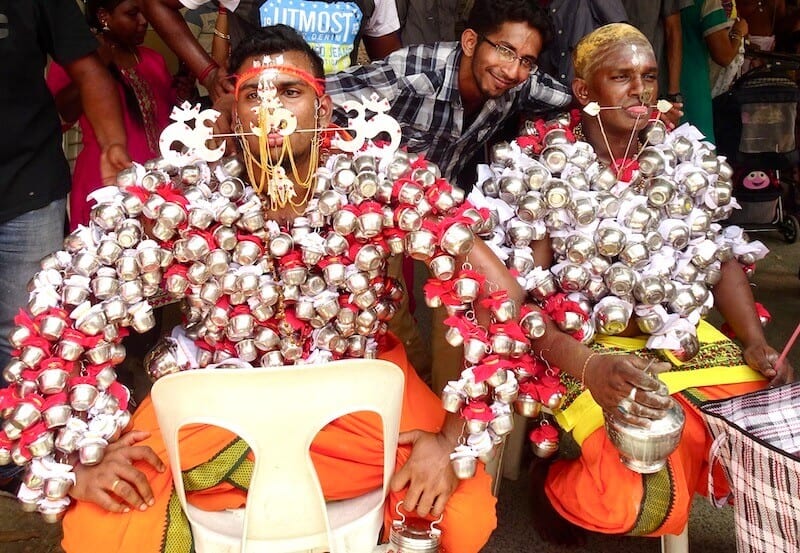
This is the most important Hindu festival of the year. And by far the largest Indian festival in all of Malaysia.
Thaipusam is dedicated to Lord Murugan, the God of power and virtue. He dispenses favors and answers prayers. The devotees make vows of gratitude. The most extreme are pierced with fish hooks and spears and walk barefoot for kilometers in the hot sun to a temple high on a hill.
Some walk to the temple carrying kavadi, or burdens, on their shoulders. Kevadis are heavy canopies constructed of various materials and decorated with colorful peacock feathers. Others give offerings of fruit and pots of milk that are poured over the statue of Lord Murugan when they finally reach the temple.
It’s one of the most monumental events in Malaysia, with millions of people coming every year. It is a celebration of religious devotion like none other I’ve seen.
If you plan to visit my little island during this time of year, don’t wait until the last minute to book your Penang hotel, or you’ll be out of luck.
Chinese New Year
Where: Everywhere there are Chinese Malaysians
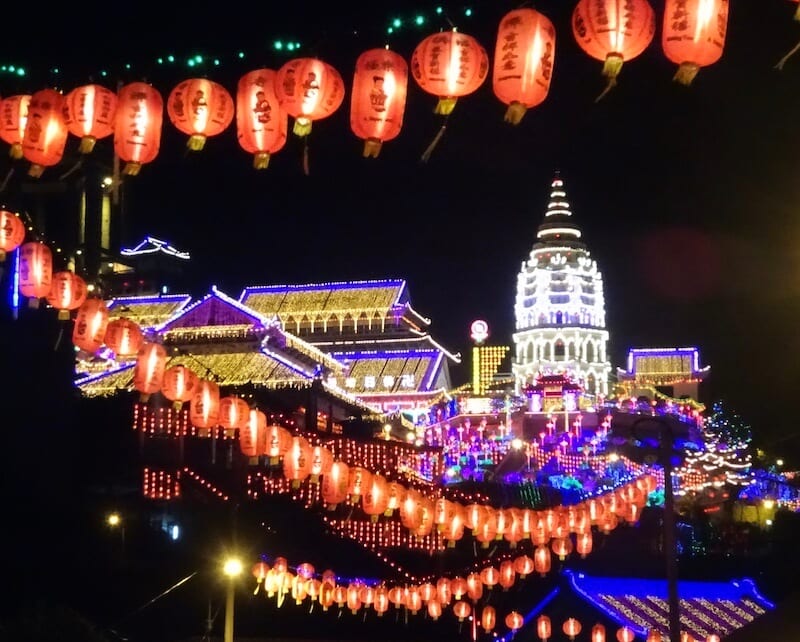
Chinese New Year is no small affair. It’s a two-week-long new year celebration in Malaysia that is not to be missed.
It’s super festive.
Red lanterns hang from all the trees, on the rooftops, in the gardens, at the restaurants. It feels like the whole of Penang is bathed in red light.
Every day you’ll hear the pounding of the drums used for the lion dance performances. Businesses, homes, condo complexes, and malls all bring in lion dance performers to bring good luck for the year.
Red envelopes called ang pow are filled with money and given to the young, old, and single people.
If you’re in Penang, go to Kek Lok Si for the display of lights. The entire temple complex, which is massive, is illuminated by 10,000 lights.
Chap Goh Mei
Where: Penang
This is the last night of Chinese New Year celebrations in Malaysia. It’s kind of like a Chinese Valentine’s Day. Single men and women write messages of love on Mandarin Oranges and throw them out to sea, hoping to find their true love.
The best place to see this tradition in Malaysia is Penang. Most places don’t throw the mandarins, but Penang goes all out with a major celebration.
Puja Pantai
Where: Carrey Island
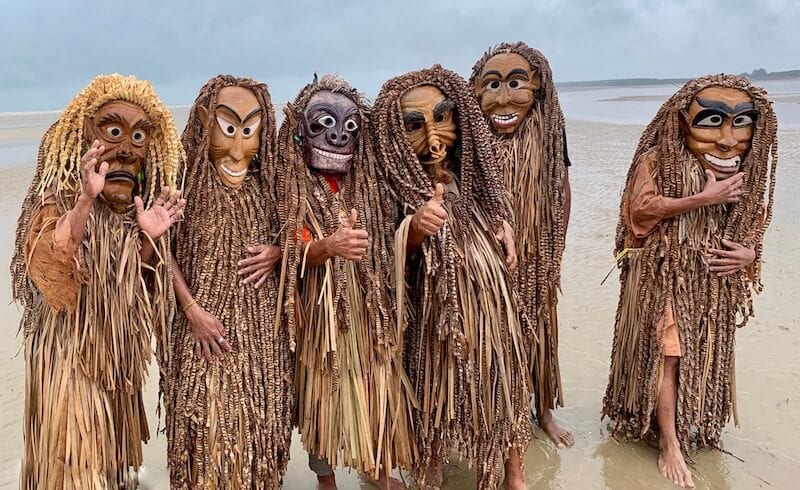
The Mah Meri are an indigenous community living in the outskirts of Klang, in Carrey Island. This lesser-known festival in Malaysia is held on the beaches on the fifth day of Chinese New Year. The ritual is performed to appease the guardians of the sea.
The Mah Meri believe that hundreds of years ago, the Mayang Getah (Spirit of Rubber) saved their ship. It was stuck in a massive storm, and everyone thought they would die. The spirit saved the boat by pulling it to shore and saving the lives of everyone on board.
Mark and I attended this year. It rained ALL day, but it was incredible to witness something that has been going on for 300 years and is so vital to the community. It’s one of the Malaysian traditions that few people know about, even locals. It was kept under cover until 2016 when they decided to share it with the world.
The Mah Meri built an alter about 400 yards out in the sand. At high tide, it’s underwater, so we had to wait for low tide and until the shamans gave us permission to make our way out there.
Three shamans started dancing, chanting, and convulsing. The villagers lined up to be blessed.
Some of the men wore intricately carved masks and clothes made of woven leaves. The drums started to thump. People started dancing. At one stage, a young Mah Mari boy started playing the violin. As the music got louder and louder, the community kept dancing in a circle and welcomed us to join in.
The culmination of the dance was everyone getting blessed by a shaman.
March
Putrajaya Hot Air Balloon Festival
Where: Putrajaya
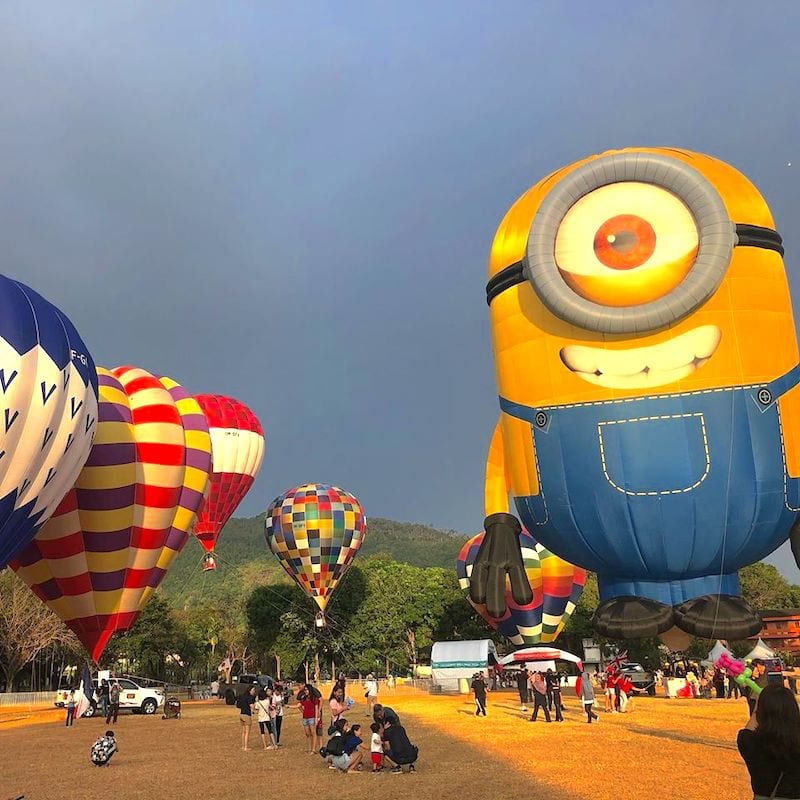
This four-day hot air balloon event starts every day off with a morning flight. Throughout the day, there are other activities like the reverse bungee, the roller orb, and the water orb. At night they have a night glow show when they light up all the balloons to the beat of a nearby DJ.
April
Songkran or Thai New Year
Where: Kuala Lumpur and Penang
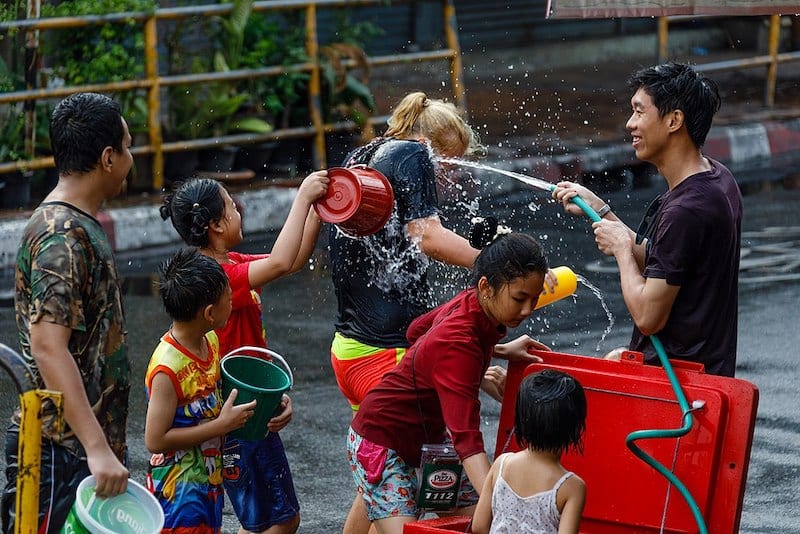
The Wat Chayamangkalaran Thai Buddhist Temple in Penang is the center of the mayhem.
People of all nationalities come to take part in a massive water fight that shuts down the street in front of the temple. Trucks with enormous water tankers park in front of the temple. The people on the truck douse anyone within reach with their super soaker water guns and buckets of ice.
The rest of us on the ground wage a useless war against the truck. We temporarily bond against our mutual enemy until everyone reloads and begins squirting each other all over again.
People of all ages are soaked and in hysterics. Everyone has the biggest smiles on their faces. It’s like being a kid again. This has to be one of the most playful festivals in Malaysia.
Penang International Food Festival
Where: Penang
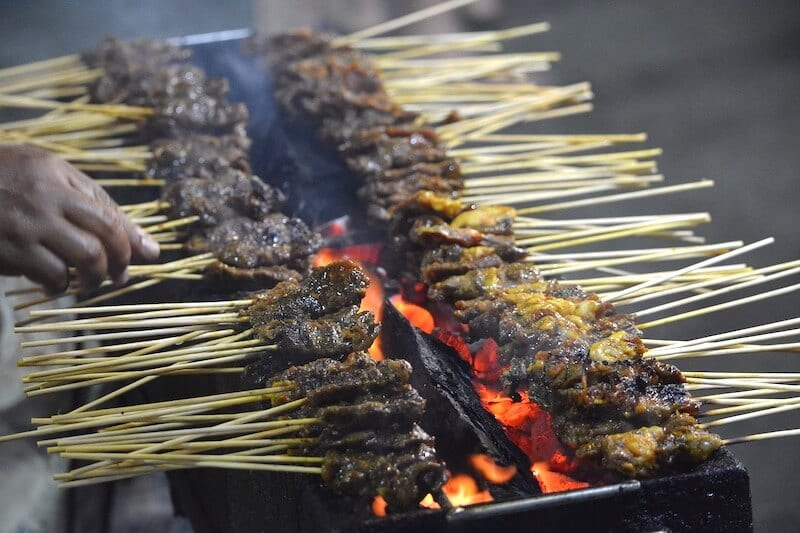
Food is such a fundamental part of the island’s reputation that there is a 16-day long festival to prove it. For years, Penang has been getting awards for its food, and it’s worthy! The festival highlights food from all around the region. From casual curry nights to fine dining in an old colonial building, it’s a pretty impressive food festival.
A few years ago there was a food truck invasion which garnered Penang the title of the world’s Largest Food Truck Rally in the Guinness Book of World Records.
They have different culinary events every year. One year we attended the Dining…Amid Water. We boarded the historical Penang Ferry for a ride under the beautiful bridges that connect the island to the mainland.
On board, we had a 4-star dinner from one of the finest restaurants on the island, Kota, while listening to a trio of musicians play everything from classical music to Ed Sheeran.
Kelantan Kite Festival (Pesta Wau Kelantan)
Where: Kelantan
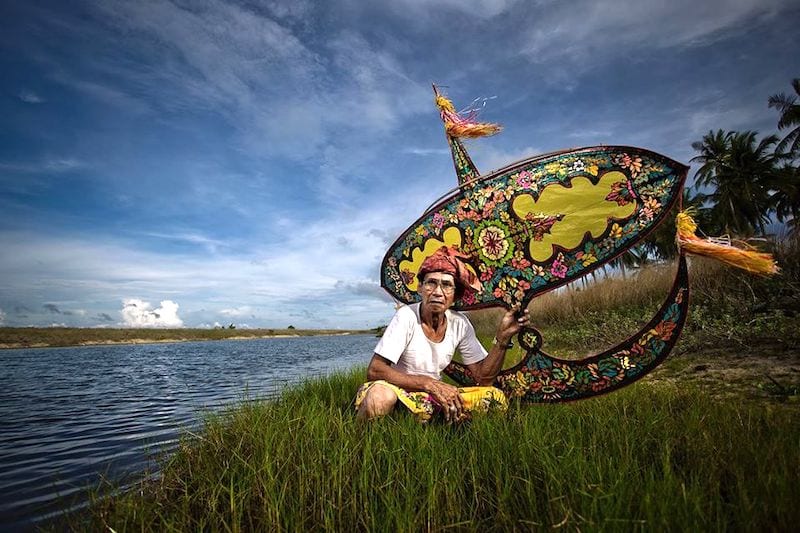
This isn’t the run of the mill little kite contest. The Wau, which is a national symbol, is a huge handmade kite that is considered an art form. Some are as large as eight feet wide and 11 feet long.
Sadly, wau making is one of the traditions in Malaysia that is slowly dying off.
People flock to the beaches of Geting to watch more than 160 international competitors show off.
This five-day festival occurs during the monsoon season to ensure the high winds needed to fly such monsters.
Ramadan
Where: Throughout Malaysia
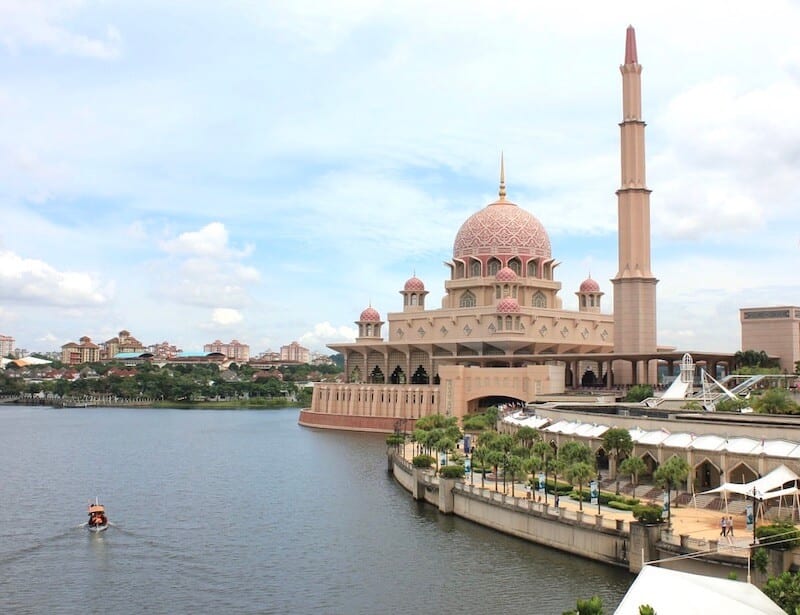
Ramadan is a month-long festival that is a time of reflection, prayer, and community for Muslims.
Muslims fast all day long and eat one meal together at sundown. They can eat at home or go to the pasar malam, or night market. The reason they fast is to cleanse their soul. To free them from impurities. Fasting teaches them self-discipline. It is also a reminder to have empathy for those who are less fortunate.
Fun fact: Read here about the first Muslim to celebrate Ramadan in space.
May
Hari Raya Aidilfitri
Where: Throughout Malaysia
This is one of the most significant celebrations for Muslims in Malaysia. It begins as the new moon rises at the end of Ramadan and is the last day of fasting month.
Many Muslims travel far and wide to be home with their families. They clean their houses, add more lighting, and celebrate with special prayers at the mosque. They visit their ancestors’ graves and call on their friends and relatives to celebrate together. Family members ask for forgiveness for past arguments, and a clean slate begins.
Some families have open houses where everyone they know is invited to come over and feast together.
Both Ramadan and Hari Raya are Malay festivals, but everyone is welcome to eat at the pasar malams around the country.
Wesak Day
Where: Buddhist populations throughout Malaysia

It’s Buddha’s Birthday! And it also marks the day of his enlightenment and achievement of Nirvana – the three most significant events in Buddha’s life.
Devotees perform a bathing Buddha ceremony in the temples. They pour water over his shoulders as a reminder to purify the mind from evil. People give donations, offer food to the needy, and release pigeons. There is chanting and praying and a procession in the streets.
Harvest Festival Malaysia (Pesat Ka’amatan)
Where: Sabah Borneo
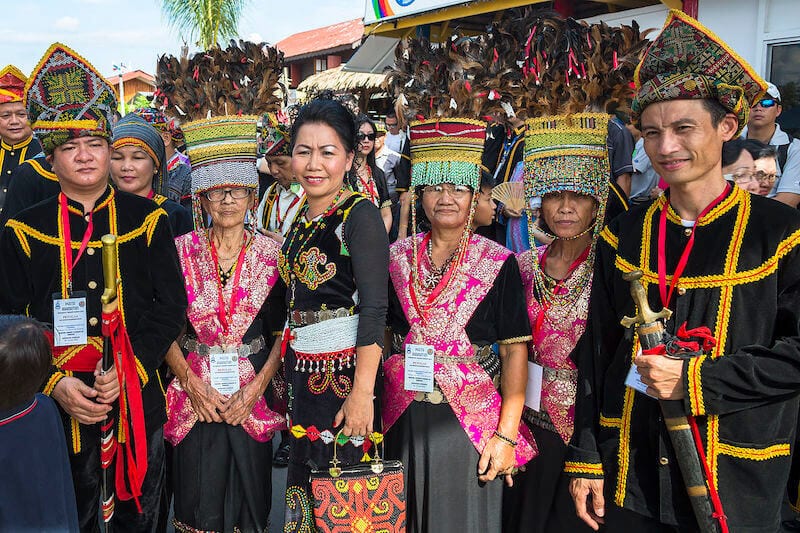
The Kadazan, Dusun, and Murut tribes of Borneo come together to celebrate the rice harvest.
Padi farmers gather in honor of Bambaazon, the spirit of the rice padi. It’s a thanksgiving festival that includes drinking loads of tapai (rice wine), cultural dancing and shows, and buffalo races. There is a blowpipe shooting contest and a beauty pageant to name the Harvest Festival Queen.
June
Gawai Dayak
Where: Sarawak, Borneo
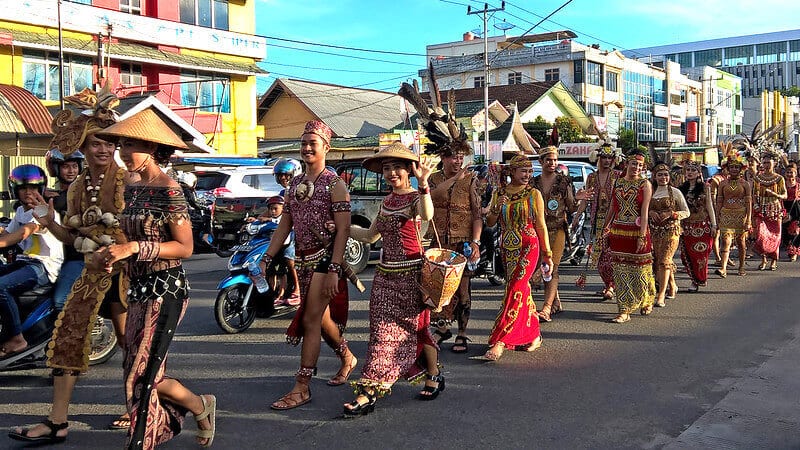
The Dayak tribe in Sarawak celebrates the end of the rice harvesting season.
It’s also the beginning of the new planting season. Just like in Sabah during the Harvest Festival, rice wine is abundant. There are parades and cultural demonstrations, weddings, and reunions. The local Dayaks hold open houses in the longhouses for anyone to come, feast, and celebrate.
July
Rainforest World Music Festival
Where: Kuching, Sarawak in Borneo
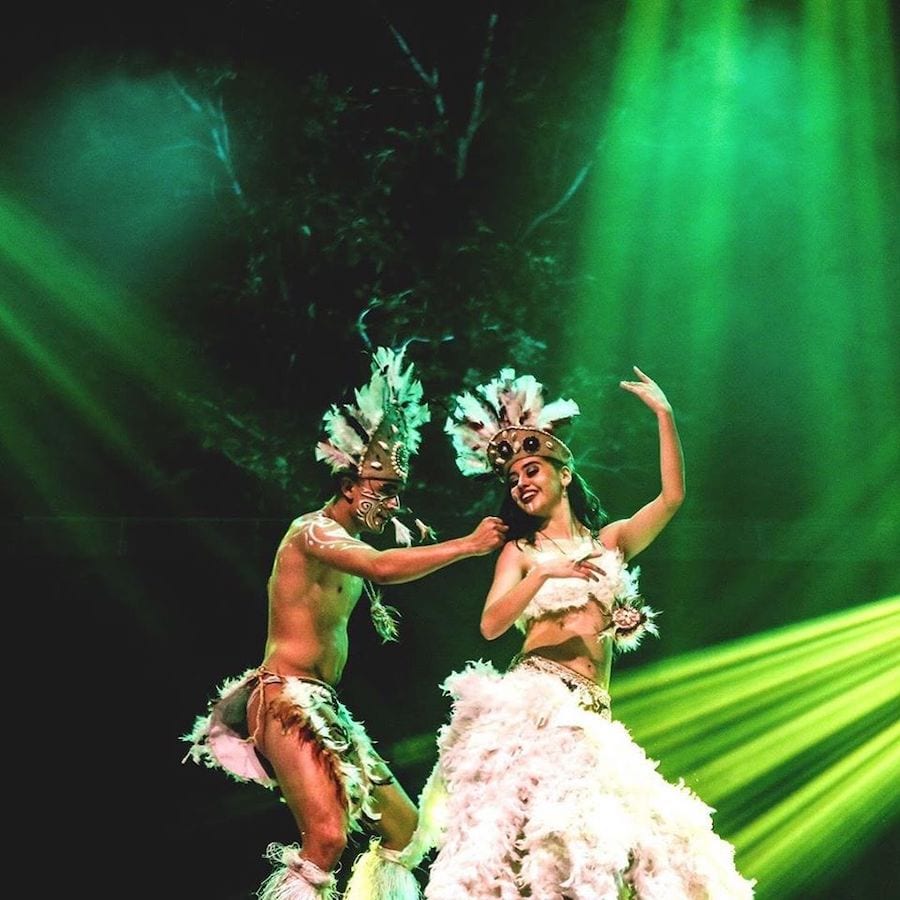
There are quite a few music festivals in Malaysia, but the Rainforest World Music Festival is by far the most unique.
Every year, world musicians flock to Borneo to perform in one of the most exotic places on the planet. Attendees from around the world come to dance in the mud and rain for this three-day festival.
Last year more than 25 artists performed from far away countries like Sweden and Jamaica.
During the day, there are workshops, and as the sun sets, the performances commence.
George Town Festival of the Arts
Where: Penang
The GTF is a month-long celebration with more than 100 unique events staged all around the city; the town is turned into a stage. Cafes host photography events. Theatres are constructed on street corners. Historical buildings revamped into theatres. Movies are shown in the parks. It is a month of honoring the arts in all forms imaginable and not to be missed.
August
Merdeka (Independence Day)
Where: Everywhere
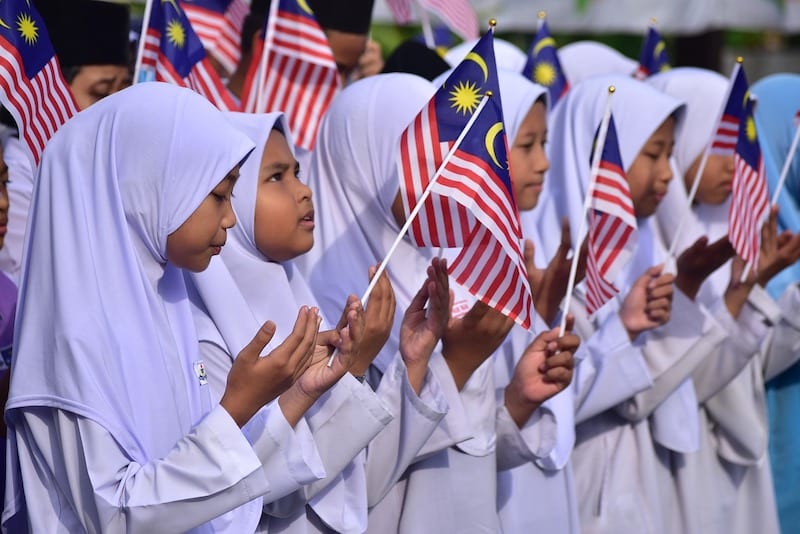
Every year on August 31st, Malaysia celebrates breaking from British rule. The big day occurred in 1957, so Malaysia is still a pretty young country.
Merdeka Square in Kuala Lumpur is where the most fantastic celebrations occur. Parades, a royal procession, floats, cultural performances, and fireworks spark the sense of patriotism like no other day of the year.
September
Hungry Ghost
Where: Wherever there are Buddhist and Taoist temples
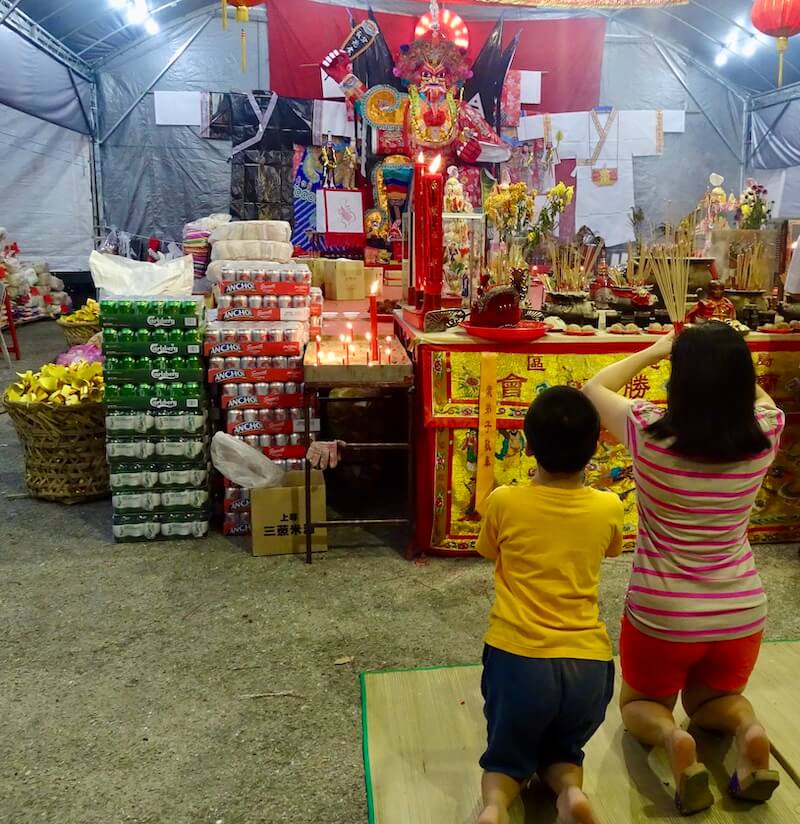
This festival is when the gates of hell are opened, and all the ghosts come out to wander the earth and cause mischief. It’s like a month-long vacation for these hell dwellers.
The living make offerings to appease the evil spirits. Candy and sugary snacks are left along the streets for the ghosts to munch on as they wander. Cigarettes, beer, and food are laid out for them.
Spirits have the same basic needs as they did when they were living. When they come out for Hungry Ghost, they need to stock back up while floating around the living realm. People burn fake money, paper cars, and cell phones so that when the spirits return to the underworld, they feel satisfied.
The locals put on operas and puppet shows, but no one will sit in the front row. The good seats are for the ghosts. Even the undead need a little entertainment.
A huge effigy of the ruler of hell gets burned on the last day of the festival.
October
Mid-Autumn Festival Malaysia or Mooncake Festival
Where: All over Malaysia
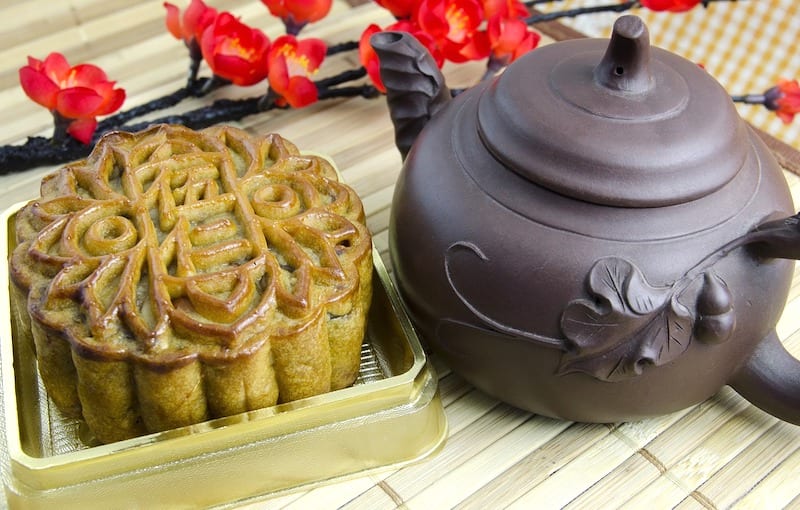
The Mooncake Festival can be traced back to China from over two thousand years ago. The Chinese would make offerings (mooncakes) to the moon Goddess, Chang Er, to thank her for a bountiful harvest.
Mooncakes were traditionally stuffed with lotus paste or salted egg, but now, you can find them stuffed with everything from apricots to chocolate. Nowadays, it’s less sacred and more of an occasion to eat mooncakes.
Nine Emperor Gods Festival
Where: Wherever there are Taoists
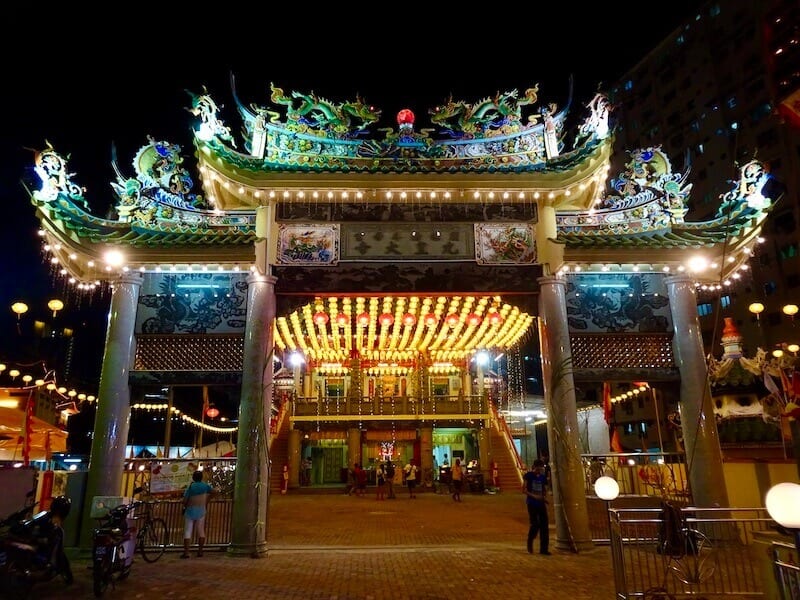
This nine-day festival is celebrated at the Taoist Temples near the water. Throngs of devotees and mediums wearing white walk from the temple to the seaside. There the mediums chant and call to the Nine Gods that are supposed to arrive on the waterway.
Once the Emperor Gods arrive, they sit in sedan chairs carried by the devotees and are brought back to the temple.
During these nine days, people keep a strict vegetarian diet to purify themselves. Some walk on fire or stairs covered in blades, while others pierce their cheeks with spears. All done to ward off bad luck and seek blessings from the Nine Emperor Gods.
People go to extremes to seek these blessings and have died in the act.
November
Deepavali (Festival of Lights)
Where: Wherever there are Hindus
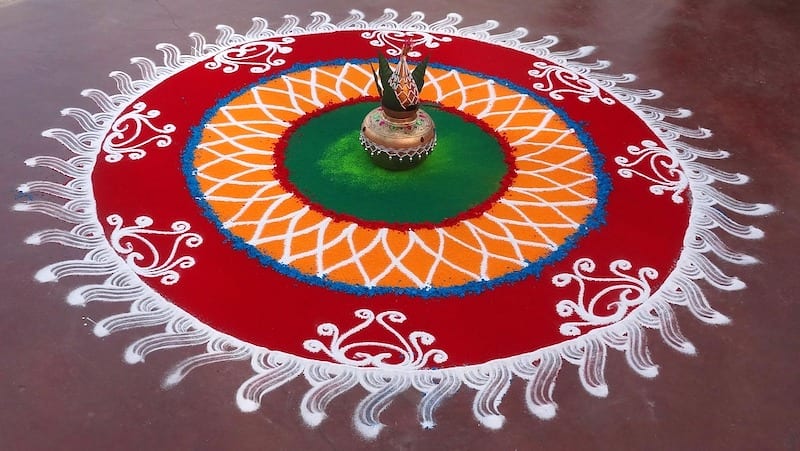
The Deepavali celebration in Malaysia is very momentous for Indians. It’s a Hindu festival that signifies the triumph of good over evil.
Oil lamps are lit to ward away the darkness and evil. Devotees create temporary kolam on the floor of their homes. Kolam, or mandalas, are intricately designed drawings made from colored rice and chalk power.
You’ll see gorgeous kolam in every mall.
If you’re lucky, you’ll get invited to a Deepavali open house to see their kolam and feast on traditional Indian food.
December
Penang International Dragon Boat Festival
Where: Teluk Bahang Dam, Penang
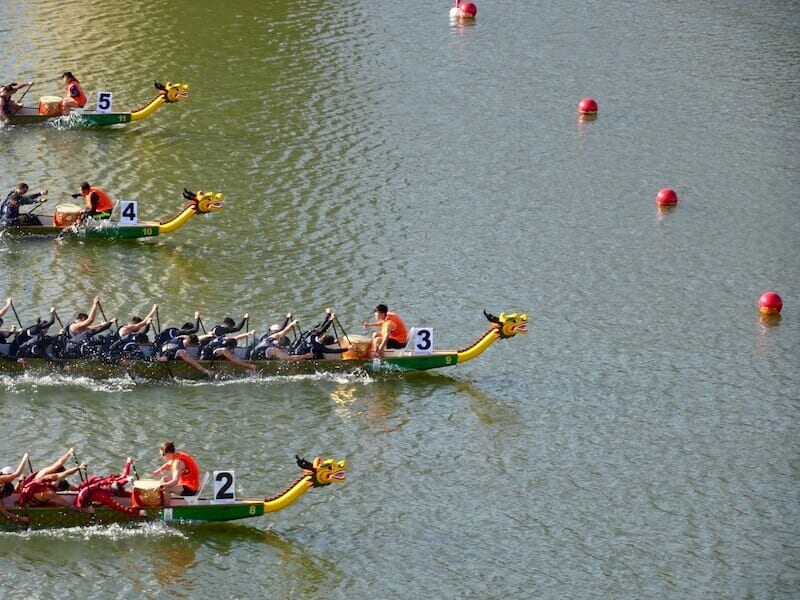
Teams from all over the world head to Penang for this two-day event. Each team has a long narrow boat with an intricate sculpted wooden dragon head at the front.
There are 22 paddlers, a sweep who steers, and a drummer who sits at the front thumping a large round drum to keep the pace.
The races vary from 100-500 meters and have multiple heats for each length.
Dragon boat racing originated in China over 2000 years ago. When the Chinese settled along the shores of George Town, Penang, they brought this tradition with them. When the race was formally organized in Penang in 1934, it was the first time a dragon boat race had ever been held outside of China.
Christmas
Where: Everywhere
Christmas is a huge event here. It is almost as festive as it is anywhere else in the world. I just wrote a whole blog on Christmas in Penang. Check it out if you want more info on the celebrations.
Year-End Review
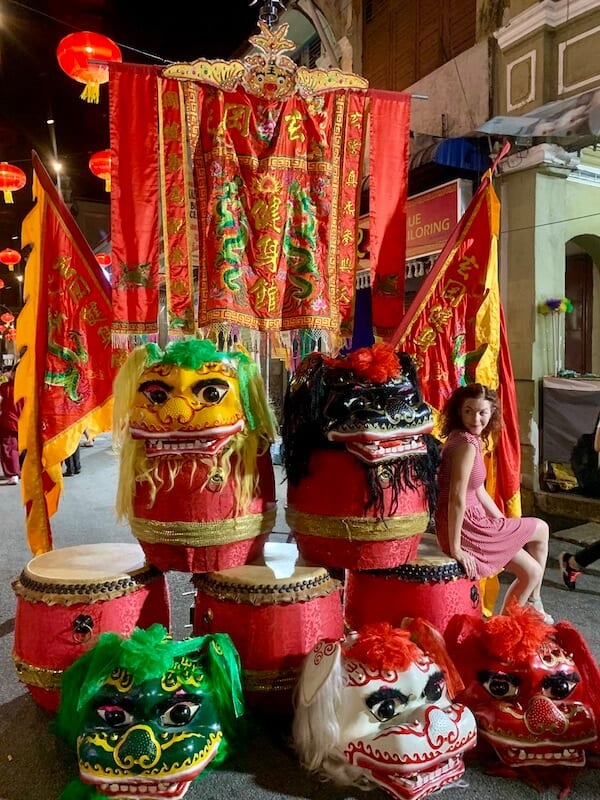
Some of these festivals follow the lunar calandar, others the Gregorian, and some the Chinese calendar. That means the dates might fluctuate a little on some of these festivals. Be sure to do your research before you come.
Now that you have the entire festivals in Malaysia 2020 calendar, you can plan your visit.
People always ask me, “Why did you move there? What makes Malaysia so special and unique?” Well, now you know. With so many Malaysian customs and traditions, I feel like I’m living in one of my University anthropology books.
If you are thinking of visiting Southeast Asia and Malaysia wasn’t on your agenda. Think again. You don’t want to miss out on any of these festivals of Malaysia.
Do any of these festivals intrigue you? Tell me in the comments. I LOVE comments!
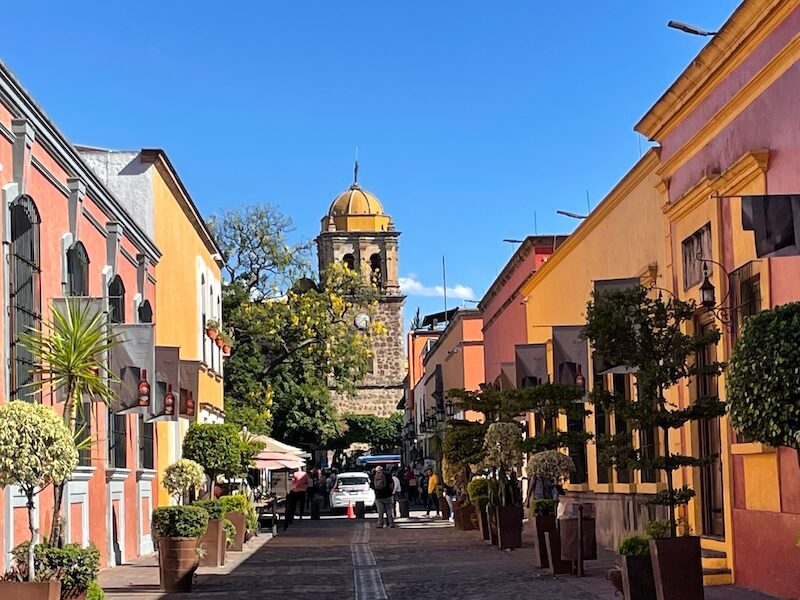
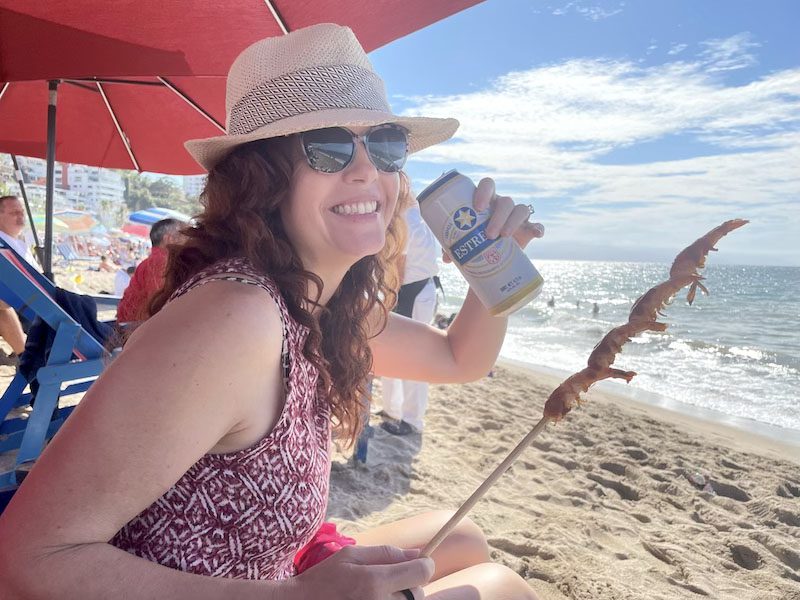
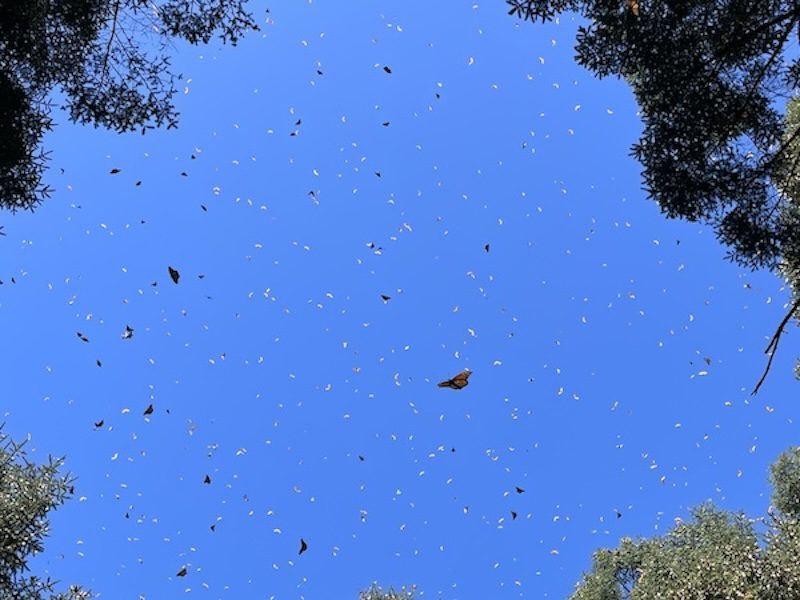
Brilliant summary! I’m a Malaysian and I love how you managed to get them all succintly
Bobby! Thank you! What a lovely compliment-even better coming from a Malaysian! There is sooo much to see and be a part of here. It is such an interesting place to live!
What a fabulous post Kirsten! I need to be home long enough to visit ALL of these festivals, they are so colourful and fun 🙂 Great photos too, you’ve really captured the spirit of them!
Thank you, Wendy! I agree! Get your booty back here!
Great piece, I read a book once about the festivals but it was so poorly written and was not factual. Thanks for setting the record straight.
Hi Mik!
You are so welcome.
Glad to see you here!
I’m sorry you read a crappy book, there are plenty out there. I am happy to be a good resource for you 😃.